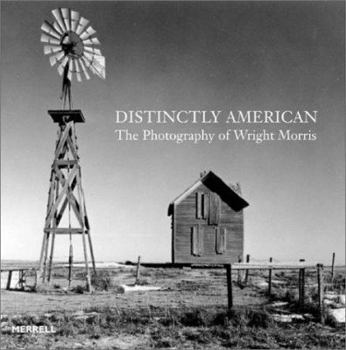Distinctly American: The Photography of Wright Marris
The images of Wright Morris (1910-1998) are the expression of his lifelong quest to capture the soul and mystique of the American Midwest. Here, for the first time, the full emotional impact of his... This description may be from another edition of this product.
Format:Hardcover
Language:English
ISBN:1858941768
ISBN13:9781858941769
Release Date:January 2002
Publisher:Merrell
Length:140 Pages
Weight:2.80 lbs.
Dimensions:0.7" x 11.3" x 11.9"
Customer Reviews
3 ratings
Distinctly Morris
Published by Thriftbooks.com User , 19 years ago
This book, with its insightful reviews and well-chosen photographs should be of interest not only to enthusiasts of American photography, but to everyone interested in photography in general. Simplicity and sincerety seems to be among the major traits of this unassuming master.
The eye of a plainsman . . .
Published by Thriftbooks.com User , 19 years ago
Growing up as Wright Morris did on the plains of Nebraska, I believe one's eye is educated by the vast grid of east-west and north-south roads, the mostly uninterrupted flat landscape, the big sky, and intense light and shadow. I see this in many of his photographs, like "House in Winter, near Lincoln, Nebraska 1940". Here a weather-beaten, abandoned house stands alone on a slight rise in a snow-covered field under a bright winter sun. The house faces the camera, only one side visible, and in the wall there is one dark, vertical window. A sagging snow fence hugs the edge of the field, and beyond it are the bare branches of a small tree. Above is a hazy scrim of clouds against open sky. The stark simplicity of the picture may strike some as deliberately formalist or minimalist. To the eye of a plainsman, it's familiar and somehow "just right." The entire collection of photographs in this book, taken mostly in the 1940s, captures a deep stillness, chiefly because they reflect evidence of human activity (houses, schools, cars, store fronts, grain elevators, interiors of houses), but in nearly all of them people are absent. Even in a barbershop, with a variety of current calendars festooning the walls and plants growing in pots and leaning toward the sunlit windows, there is no one. The chairs are empty. It's easy to oversimplify the intent of these photographs, as Alan Trachtenberg and Ralph Lieberman argue in their essays included in this book. For me, they represent a way of seeing that looks for balance and rest, while acknowledging at the same time that everything must change. The tension between those two things is captured ironically in the last photo, "Juke Box, Southern Indiana 1950," in which a glorious, 1930s-style, lighted juke box stands against a wall under two framed pictures, what looks like a ceramic flying fish, and in the upper left corner a sign reading, "No Dancing." This book of 80 beautifully reproduced black and white photographs includes a chronology of Wright Morris' career as writer and photographer (1910-1998) and a bibliography of books by and about him. A handsomely designed and elegant book. Worth having.
A quiet and compelling Wrightness.
Published by Thriftbooks.com User , 20 years ago
The eighty wonderful photos in this book cover sixteen years from 1934 when Morris made several trips across America. He sought out the commonplace everywhere, though most of the photos here are from his beloved Midwest and mostly exteriors of weather-beaten buildings. They all have a stillness about them, helped by the straightforward way Morris arranged the shots, there are no crazy angles, soft focus or wastage. All the photos are beautiful compositions and in the case of the buildings they are shot face on to show textured wood and the almost abstract shapes that a roof, chimney or porch creates when a shadow falls across them. The interior photos are of rooms and close-ups, a dresser draw or a kitchen table with household bric-a-brac. None of the pictures include people (except for 'Uncle Harry entering a barn' on page 113) and this might put some viewers off but Morris wanted to use the images and combined them with his writing in 'photo-text' books like 'The Inhabitants' (1946) or 'Home Place' (1948). I think this book, beautifully printed and designed, is an excellent reminder of a visual poet who was distinctly American. ***FOR AN INSIDE LOOK click 'customer images' under the cover.






